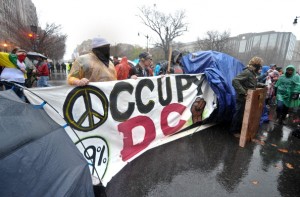Race, Class and the District: Top Five Stories of 2011
As the year comes to a close, DCentric is looking back on the five big stories where race and class intersected. Do you think there’s something we missed? Let us know in the comments section:

Nicholas Kamm / Getty Images
Occupy DC protesters block the intersection of 14th and K streets, NW.
The Occupy Movement spreads around the world and takes root in D.C.
The Occupy Movement began in New York City and spread to other cities, including D.C. Protestors have focused much of their ire on the economic inequality that’s left the nation’s wealth in the hands of a very small minority. There has been a fair share of criticism of the movement, including some targeting its lack of representation of those who have been most hurt by the economic crisis: people of color. In recent weeks, protesters have decamped in numerous cities, but their presence remains in D.C.
D.C. no longer “Chocolate City.”
This was a landmark year for the District when it comes to demographics. D.C.’s black population dipped below the 50 percent mark sometime in February, according to census estimates. This comes after more than four decades of the District being “Chocolate City,” a nickname reflecting its status as a majority-black city. D.C. also led states in population growth in 2011 for the first time in more than 70 years.
The first memorial honoring an African American opens on the National Mall.
Blacks still constitute the largest single racial group in D.C., and have long been at the fore of the District’s political and cultural landscape. One place where African Americans have been noticeably absent is among those memorialized on the National Mall. That changed this year with the dedication of the Martin Luther King, Jr. Memorial. But it wasn’t all celebration; some took issue with the fact that the sculptor was a Chinese national, while others were dismayed by King’s stoic expression or the quote selection.
D.C. Mayor takes office after an election characterized by a stark racial divide.
Mayor Vincent Gray was sworn into office Jan. 3 after a hotly contested race in which he won the majority of the black vote, while incumbent Mayor Adrian Fenty won the majority of the white vote. But despite such racial divisions in the election returns, Mayor Gray has spent much of his time in office touting his “One City” approach to governance. How effective that’s been is debatable, especially since his office and other D.C. lawmakers been embroiled in scandal after scandal.
The District remains one of the most expensive places to live.
While most of America’s cities saw their housing prices drop, D.C.’s continued to rise in 2011. At the same time, the District remained home to stark disparities in just about every aspect of life, from finding a job to eating fresh produce to having Internet access.
-
http://www.adsyou.com/ شقق للبيع في الاردن





